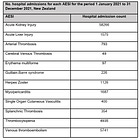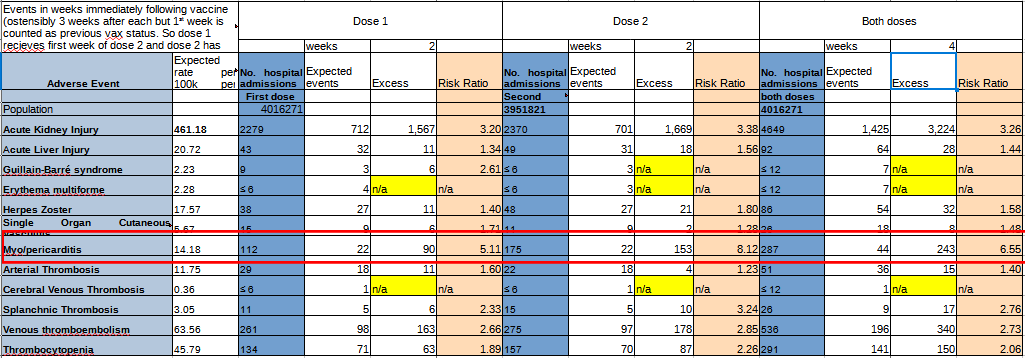How Accurate is NZ's vaccine Side Effect reporting?
A comparison between reports to NZ's vaccine side effect reporting system 'CARM' and actual post vax hospital admissions.
Some months ago I obtained the data for hospitalisations for 12 out of 39 conditions known to be associated with the Covid shots.
This data showed that there were more than 40,000 excess hospitalisations for these conditions in just the first year of the rollout.
I’ve been distracted trying to get the data for the other 27 conditions since then… to no avail…yet.
But there’s more valuable information in that original OIA data. Here I will use it to compare to Medsafe’s CARM reports for adverse events to see how well our adverse event monitoring system is working. Spoiler alert- it’s worse than terrible.
CARM in New Zealand is the equivalent of VAERs in the US, or the Yellow card system in the UK. Like the other reporting systems around the world, CARM admits they only capture a fraction (5%) of actual Adverse Events (AEs).
“still room for improvement”, at only 5%, you don’t say!
The hospitalisation data was first used by the MOH to produce a pre-print study. You can access the data from the original OIA here, but below is the data representing, ostensibly, the first 3 weeks following each vax dose. I show it in the dark blue columns. ( FYI, I added the other columns in the table to work out the elevated Risk ratio by comparing to annual expected rates for each condition per 100k- that’s another story for another day).
The problem with the above information supplied by the MOH is that if you search the MOH database for events within the 3 weeks following reception of a vaccine dose, you will not return the 1st week’s data after each dose. This is because the vaccination status is recorded as it was 1 week prior to hospital admission. So someone who had an AE in the first week after the 1st dose will be recorded with the unvaccinated instead. Similarly, someone who goes to hospital within 1 week following the 2nd dose will be recorded as having 1 dose, but because it would have been more than 3 weeks from their first dose date (you have to wait 3 weeks between doses), they would not show up in the 1 dose data either because that only covers the 1st 3 weeks. This is a big problem with the data. Not only does the data, which the MOH used in their study published in March (now withdrawn… I wonder why?), cover only 4 weeks instead of 6, but the first week would be expected to have the most AEs in it… as you can see below in this CARM report graph for myo & pericarditis.
Now down to the nitty gritty. I will focus first on myo/pericarditis because it is the only AE for which CARM supplies a nice ‘Time to Onset’ graph (see above-I added the horizontal lines for additional clarity). We have the data for hospitalisations for weeks 2-3 following each dose from the MOH OIA, and the number of reaction reports to CARM for those weeks from the graph above, so now lets put them together…

We can see that only 52 out of 287 or 18% were reported.
That’s higher than 5% but don’t be too hasty to give high fives to CARM just yet. Given the high profile given to myo/pericarditis, we would expect a higher reporting rate than normal, but please keep in mind that not all myo/pericarditis needs to be hospitalised. Many are treated with drugs and rest time at home. So the actual number of cases would be far higher than 287 and consequently the reporting rate far lower - possibly still only 5% if you take into account these non hospitalised cases.
You would no doubt have heard that CARM (or VAERS, or Yellow Card etc) reports ‘do not prove causality by the vaccine’ anytime CARM reports are quoted in the MSM. However, table 1 above shows that 85% of the admissions (243/287) were excess to normal expectations and, with close temporal association, can not reasonably be ascribed to any other cause except the vaccine. The CARM reporting for Myo/Pericarditis turns out to reflect only 21% AT THE MOST of actual cases caused by the vaccine. And that is the most serious ones at that. If you see one case of myo/pericarditis reported on CARM it reflects about 5 cases that end up in hospital. These are certainly not ‘mild’ cases that ‘resolve by themselves within a few months’ as the MSM would have you believe. This Swedish study shows that 8% of those hospitalised for myo/pericarditis die within 1 year. So we can reasonably say that the 52 CARM reports that occurred in the first 3 weeks following a vax dose would have resulted in 19 deaths within a year. And no, Rory Nairn (R.I.P) would not be included as one of them- tragically, he didn’t even make it to hospital.
That’s Myo/pericarditis dealt with. Lets have a look at the elephant in the room: Acute Kidney Injury (AKI). Heres the table of AEs reported to CARM after the first year of vaccination:
No need for fancy calcs on this one. CARM reports just 23 cases of AKI, the hospital admission data for just weeks 2-3 after each dose totals 4649. If I make allowance for the missing 1st weeks at the same rate it’s 6973 hospitalisations. That’s a CARM reporting rate of only 0.3% . When compared to the excess hospitalisations, which, like myo/pericarditis, can not be reasonably ascribed to anything other than the vaccine, we see that the CARM reports represent only one out of ~200 actual vaccine side affects that put the victim in hospital. That’s a catastrophically bad monitoring system!
Comparing all the AESIs in the MOH hospitalisation data with CARM reports is never going to be an accurate reflection of CARM reporting accuracy because not everyone gets hospitalised so for most other conditions it’s going to skew it in favour of CARM accuracy especially for AEs with low hospitalisation rates. But when we see that CARM reports for AKI, which is one which normally has a high hospitalisation rate, can only count 0.3% of cases with high temporal association to vaccination, and is 200 times below the likely actual rate of side effects, what hope can we have for any of the other CARM reports being anywhere near accurate?
Is AKI Serious?
Studies into mortality from AKI vary. This one shows >25% die within 90 days, and this one shows up to a 62% death rate over 4 years. But most studies include, along with those hospitalised for AKI alone, people hospitalised with other conditions who develop AKI in hospital, and mortality rates vary depending on the cause of the AKI as well, so I don’t think we can draw direct comparisons. Vaccine induced AKI would need (and should get) a mortality study on it’s own. Suffice to say, AKI is very serious and the hospitalisation cases following vaccination given by the MOH would likely represent many hundreds, possibly thousands of deaths across the whole year.
Yet CARM only recorded 23 cases out of approximately 7000 in the first year of vaccination. Was even one of them investigated?
This puts the lie to the idea that the MOH is ‘closely monitoring vaccine side effects to ensure safety’.






A gem of article that supports my current investigation.